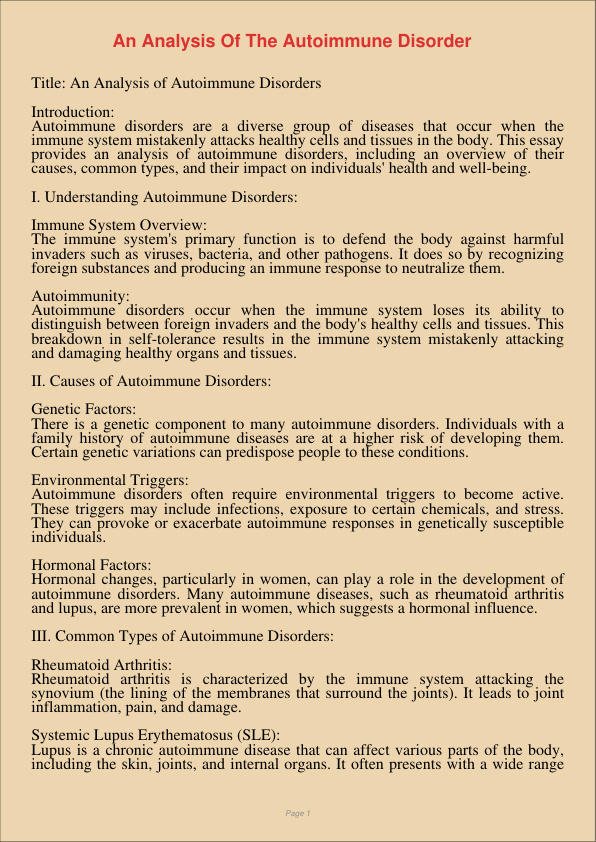
Title: An Analysis of Autoimmune Disorders
Introduction: Autoimmune disorders are a diverse group of diseases that occur when the immune system mistakenly attacks healthy cells and tissues in the body. This essay provides an analysis of autoimmune disorders, including an overview of their causes, common types, and their impact on individuals’ health and well-being.
I. Understanding Autoimmune Disorders:
Immune System Overview: The immune system’s primary function is to defend the body against harmful invaders such as viruses, bacteria, and other pathogens. It does so by recognizing foreign substances and producing an immune response to neutralize them.
Autoimmunity: Autoimmune disorders occur when the immune system loses its ability to distinguish between foreign invaders and the body’s healthy cells and tissues. This breakdown in self-tolerance results in the immune system mistakenly attacking and damaging healthy organs and tissues.
II. Causes of Autoimmune Disorders:
Genetic Factors: There is a genetic component to many autoimmune disorders. Individuals with a family history of autoimmune diseases are at a higher risk of developing them. Certain genetic variations can predispose people to these conditions.
Environmental Triggers: Autoimmune disorders often require environmental triggers to become active. These triggers may include infections, exposure to certain chemicals, and stress. They can provoke or exacerbate autoimmune responses in genetically susceptible individuals.
Hormonal Factors: Hormonal changes, particularly in women, can play a role in the development of autoimmune disorders. Many autoimmune diseases, such as rheumatoid arthritis and lupus, are more prevalent in women, which suggests a hormonal influence.
III. Common Types of Autoimmune Disorders:
Rheumatoid Arthritis: Rheumatoid arthritis is characterized by the immune system attacking the synovium (the lining of the membranes that surround the joints). It leads to joint inflammation, pain, and damage.
Systemic Lupus Erythematosus (SLE): Lupus is a chronic autoimmune disease that can affect various parts of the body, including the skin, joints, and internal organs. It often presents with a wide range of symptoms.
Multiple Sclerosis (MS): Multiple sclerosis is an autoimmune disorder that affects the central nervous system. The immune system attacks the protective covering of nerve fibers (myelin), leading to communication problems between the brain and the rest of the body.
Type 1 Diabetes: In type 1 diabetes, the immune system targets and destroys insulin-producing cells in the pancreas, leading to insulin deficiency and high blood sugar levels.
Hashimoto’s Thyroiditis: This autoimmune disorder affects the thyroid gland, leading to underactivity (hypothyroidism). It can result in symptoms such as fatigue, weight gain, and cold intolerance.
IV. Impact on Health and Well-Being:
Chronic Inflammation: Autoimmune disorders often result in chronic inflammation, which can cause pain, discomfort, and damage to affected organs and tissues.
Variable Symptoms: Symptoms of autoimmune disorders can vary widely between individuals and may be unpredictable. This variability can make diagnosis and treatment challenging.
Quality of Life: Living with an autoimmune disorder can significantly impact a person’s quality of life. Chronic pain, fatigue, and a range of symptoms can limit daily activities and affect mental health.
Treatment: While there is no cure for most autoimmune disorders, various treatments aim to manage symptoms and suppress the immune system’s abnormal response. These treatments may include medications, lifestyle modifications, and, in some cases, immunosuppressive therapies.
Conclusion: Autoimmune disorders represent a complex group of diseases with various causes and manifestations. These conditions have a significant impact on individuals’ health and well-being, often requiring ongoing management and treatment. Understanding the underlying mechanisms, common types, and the interplay between genetic and environmental factors is crucial for both healthcare providers and patients in effectively managing and living with autoimmune disorders.
「真诚赞赏,手留余香」
真诚赞赏,手留余香
使用微信扫描二维码完成支付
